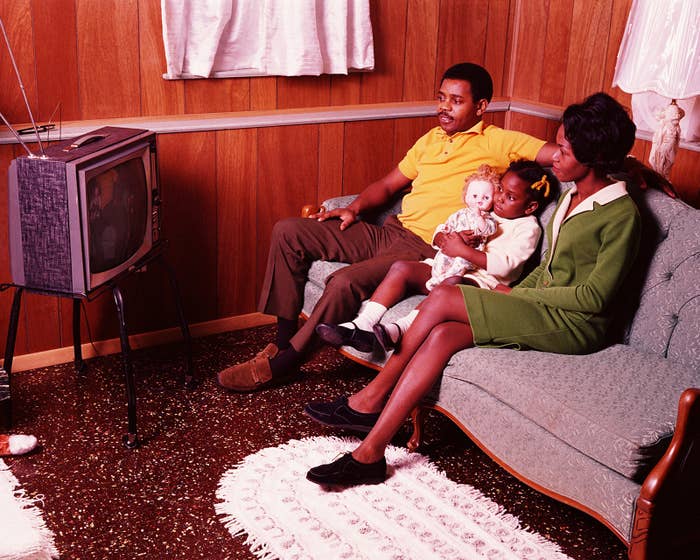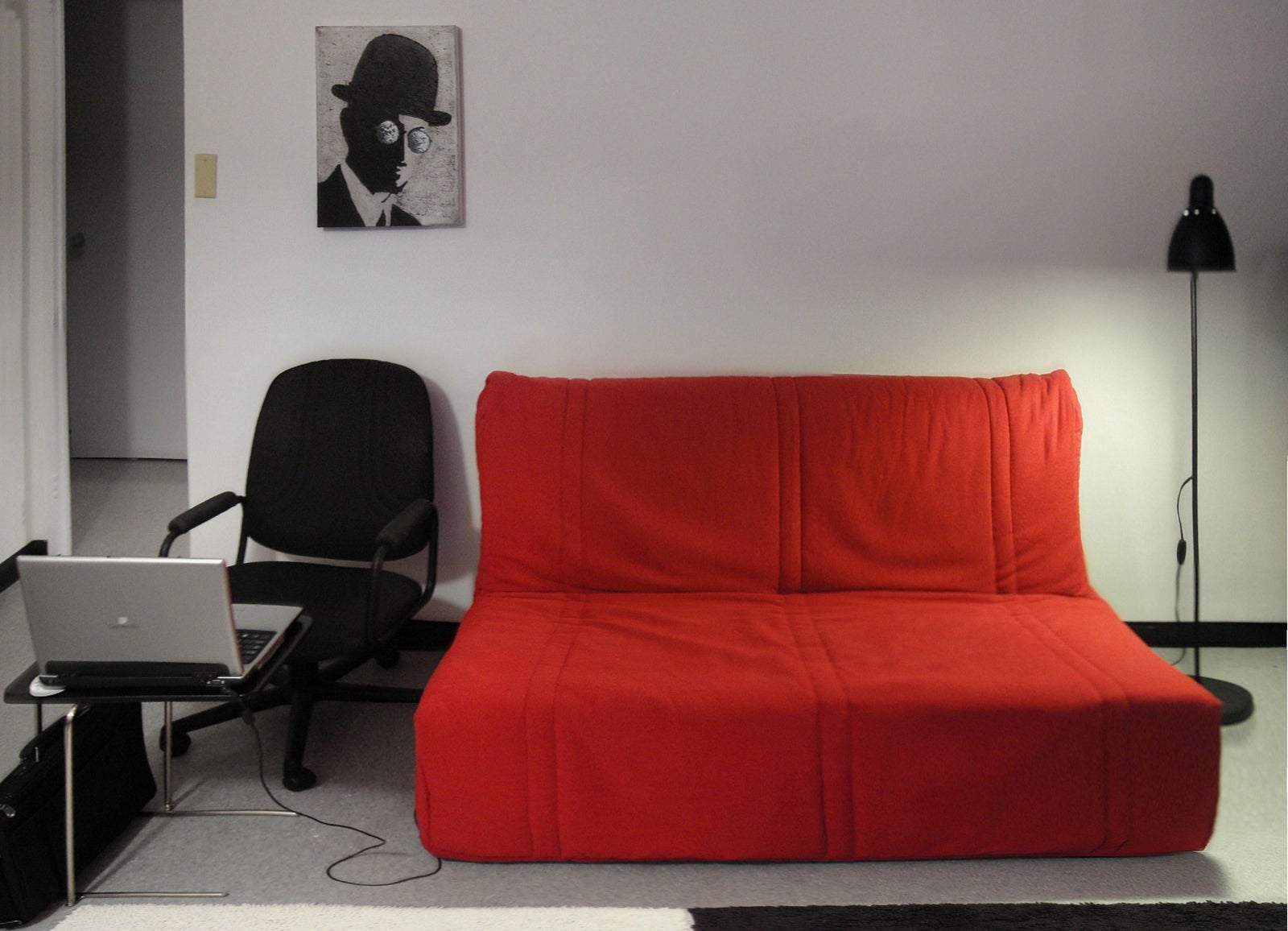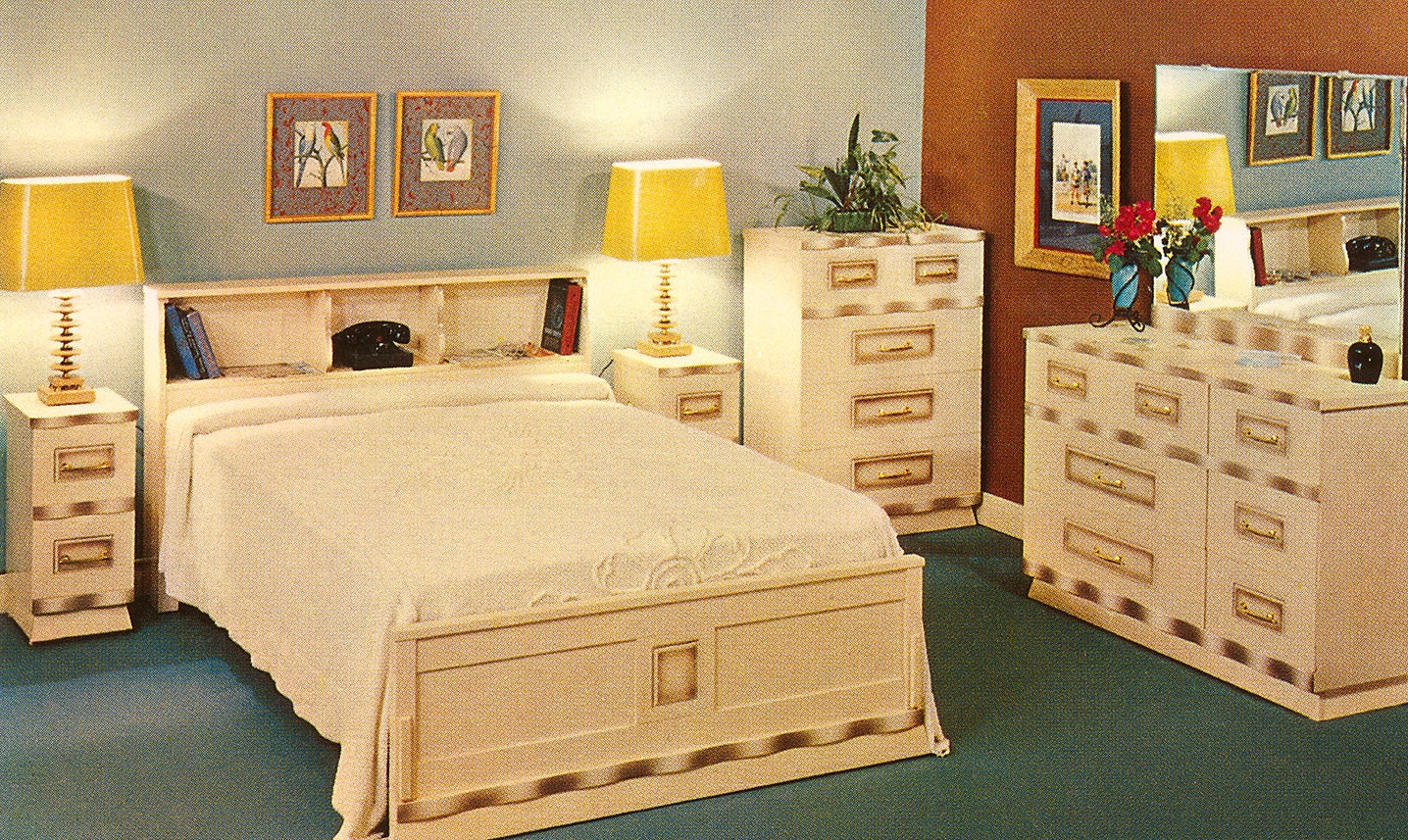There’s a couch that’s in the backdrop of so many of my childhood photos, and if I concentrate, I can feel its texture: a bushy velvet, soft and pliant. Slate blue with white leafy fronds. It was passed down to my parents in the early ’80s, when they were living in Minneapolis, from my grandparents, who’d had it in their basement — purchased sometime in the 1950s.
When I was a toddler, my grandmother reupholstered it with the fabric I loved, stapled and sweating through the Minnesota summer while I napped. It traveled with our family when we moved to Idaho, one of our only pieces of furniture, a centerpiece of the living room. It moved to the new house we built down the street, where it became the TV room couch, home to hundreds of hours of cartoons and Star Trek: The Next Generation and MTV. My brother and I would hang upside down from it, our hair grazing the carpet, seeing how long we could last until the pounding in our heads became impossible to bear.
Sometime around 1997, its springs became discernible. It didn’t make the move to the next house. No one in my family can remember where it went, just that it didn’t end up on the curb. It was at least 40 years old.
That blue couch survived as long as it did because its framing was solid wood; whatever its stuffing was, it held on for decades, not years. My grandparents, who’d lived through the Depression and, afterward, lived with great thrift, likely purchased the couch with a mind that it would be passed down to one of their three sons. It was a fixture of their home, and it became a fixture of our home.

Many of us have stories like this from our childhoods: of items passed down and, gradually, worn out. But for our kids these types of stories will be increasingly rare: We move too much, we have less room, we don’t care nearly as much about furniture — in part because the furniture we do buy is so shitty.
Demographics bear this out: 30% of those between the ages of 20 and 29 will now spend time abroad; less than 60% of Americans now live in the same state they were born in. That may seem like a lot, but according to US Census Data, it was almost 70% in 1950. General mobility is up, in part because the time between graduation from high school or college and “settling down” is expanding: The average age of marriage has risen to 27 for women and 29 for men (in 1990, it was 23 for women and 26 for men in 1990), and the average age of motherhood has risen from 24.9 (1990) to 26.3; the average age to purchase a house has risen to age 33.
People born between 1990 and 2000 are now more than 2.4 times more likely than the average American to be paying off student loans, and have a median income of $24,973; older millennials’ median income is still just $47,854.
And then there’s the way we live: Two-thirds of millennials are renters, and in those rentals, they’re more likely to live with roommates than alone. Sixty-two percent prefer to live in “urban centers” — a dramatic shift from our parents’ generation. Only 66% of millennials under 25 own a car. When we do have money, we spend it on vacations, pay off debt, or save it — only 16% report spending excess funds on “home improvement/decorating.” The places we live are likely to be smaller and urban and shared; we have less space to fill, fewer ways to fill it, and less inclination to devote our funds to doing so.
Furniture is a signifier of taste, an indicator of both social and physical mobility, a testament to one’s stage in life. And all of those thing have changed, some of them dramatically, between our parents' generation and ours. The styles of furniture, and what’s fashionable, have always been evolving, but the sociological shift in where it fits in our lives is dramatic and telling. Simply put, we think of furniture differently — which is, in truth, a way of saying that we think about the trajectory of our lives differently.
I was born in 1981, which places me on the far end of what marketers call “old millennials” — and particularly poised to observe just how effectively the furniture revolution has transformed my life and the lives of other (middle-class) millennials. I graduated from college in 2003 and spent the next decade moving all over the place: Over my graduate career and following attempts to secure a job, I moved to Seattle, Oregon, Texas, Vermont, and back to eastern Washington state before ending up in New York.
I earned very little, surviving mostly on student loans; the furniture in my first single apartment, where I moved two years after graduation, was a mix of graduation presents (bed), flea market shabby-chic acquisitions (dresser, table, chairs), Target and Ikea (bookshelves), and hand-me-downs (a dresser, hand-stained by my mother when I was a toddler). By the time I arrived in New York, 10 years later, I’d shed every single one of these things. Most had broken — in transit, by movers, or maybe when I just looked at it funny — or been left behind when I realized that that “bookshelf” was actually just “pieces of glass with cheap metal.”
Again, this should sound familiar. Our micro-generation is sometimes called the “Ikea generation,” in part because we’re the first to graduate from college and turn so forcefully toward a single provider of furniture. This finding is borne out in a totally nonscientific survey I conducted, of 770 people of various ages, socioeconomic backgrounds, and locations. Hundreds said that their first furniture was some combination of Ikea and something else. A 24-year-old from Washington, DC, who identifies their gender as nonbinary, said, “Everyone I know in their 20s is an Ikea addict.”

The experience of a 33-year old self-identified middle-class woman, who got her first solo apartment in Seattle in 2007, was typical of the answers I received:
I splurged on a decent mattress set from a small local store whose name I can't recall. My mom bought me a coffee table from Amazon, I think, and it held up surprisingly well for several years. I got a rickety, cheap dining table and folding chairs from Ikea and a semi-decent computer desk from World Market. Nothing handed down, because my family was on the other side of the country. I didn't have a car, either, so thrift shopping for large pieces wasn't possible.
A mattress, a few items under $200. Other respondents received some items from their families: One woman, age 27, “inherited a lot of furniture on its last legs (old chairs, a twin-sized futon chair, my childhood bedroom set)” and “slowly built up the rest from Ikea and scrounging around”; a 26-year-old woman who first moved to Madison, Wisconsin, said, “I bought a big dresser with a mirror at a garage sale, dug my childhood desk out of my parents’ house, bought an Ikea couch and Target coffee table, and set up a kitchen table I was handed down from my cousin.”

The unifying sentiment toward the vast majority of this furniture was apathy. As a recent piece in Furniture Today explains, the Ikea generation is “the group least satisfied with their furniture — what little they have.” There’s two reasons for this. The first is practical: We move so much, and our furniture is so cheap, that it’d be foolish to overly attach ourselves (financially, psychologically) to a piece of it. When I moved, I never had enough money to pay for good, non-schemey movers; my furniture steadily acquired dings and dents; some parts were lost, others broken. An Ikea dresser fell apart; a moving company lost the frame of my futon.
In my survey, I asked people about what they lost in moves, and Ikea stuff filled the list. There was the “cool dining table from Ikea that couldn’t be reassembled,” an Ikea wardrobe that broke, a cheap Ikea coffee table that disintegrated. A 33-year-old middle-class woman who now lives in the suburbs lost two of the same Ikea dressers that I had: “Those things can’t survive moving trucks,” she said.
“A lot of what is in our homes seems very temporary — like, this piece will do for now, until I have money/a place to live for more than a year/find something better,” one 27-year-old woman from Chicago said. “I think a lot of us do want heavy, well-made objects with history, but it just doesn't quite line up with budget and life stage. Stuff kind of weighs you down, too, and that's something I think a lot of young people are looking to avoid.”
You can see that last idea — the desire to live a life unencumbered by stuff — in the popularity of the “decluttering” movement, which proselytizes the extremely bourgeois idea of pruning your possessions as a form of liberation. The thing about Ikea stuff — like Target or Walmart stuff — is that even if you keep it in your life, you could, feasibly, leave it behind at any moment: to move, to travel the world, to pursue a lead on your dream job, to follow your bliss. That attitude toward stuff is made possible, of course, by the lack of larger things weighing you down: It’s easy to be blasé about furniture when you’re delaying marriage and parenthood and home ownership, either by choice or by necessity.
Want to read more articles like this one? See the rest of our To Build A Home series here.
Another reason we don’t care (as much) about our furniture: Our taste is different than our parents. We tilt towards mid-century modern — an aesthetic many of our parents still conceive of as the furniture style of their parents. But we also care less about things like “furniture sets” — i.e., buying large groups of furniture that match, are meant to be kept in one room, and cost thousands of dollars. That’s the kind of stuff that’s made of real wood, and is bought on payment plans at old-school furniture stores you’ve probably never set foot in.
“My mom likes things to match,” a 39-year-old currently living in Whittier, California, explained. “When I was growing up she had a huge cherrywood bedroom set. Headboard and footboard, matching nightstands, 2 dressers, one with a huge mirror in a frame.” A 33-year-old in Denton, Texas, said that her parents buy furniture that is “big and heavy and expensive.”
“It comes into their house and stays in one place for years and years,” she continued. “I tend to look for furniture that is either very cheap and can be easily replaced, or can be rearranged to fit different spaces. (No sectional sofas or large dressers here — what if our next living room is smaller or our bedroom walls have more windows?)

Matching furniture, massive sectional sofas, bedrooms sets, the sort of things you put in a house, likely in the suburbs, that you own and from which you won’t move — for boomers, those are the signifiers of becoming an adult, of making it. Younger people, by contrast, mark adulthood with the purchase of an expensive piece — and the accumulation of more durable items, if not necessarily more expensive, that better represent their individual taste.
That big, adult, non-Ikea purchase is usually pegged to a big life change: a marriage, buying a place, finishing grad school, getting a big promotion, or having a kid. Cue: the West Elm couch (or equivalent thereof), a signifier of true “adultness.” A study commissioned by online lender Earnest found that 24 is the “peak” Ikea customer age, and those customers then spend the rest of their twenties gradually amassing slightly more upscale items (from Bed Bath & Beyond and Crate & Barrel, both of whom have a peak customer age of 31) until they reach West Elm and Williams Sonoma (age 33) and CB2 (age 35).
This study totally fucking nailed me. I bought my first West Elm sofa — the Finn, in “chenille tweed,” far too small for two grown people — at age 33. It cost $850, plus $200 for delivery. I thought it was the greatest, most adult thing in the world. I surrounded it with a table from a vendor specializing in reclaimed wood on Etsy, a butcher block that I “Ikea hacked” into something cuter, and an end table from a reclaimed furniture store in Brooklyn.
I thought I was being original, but I was incredibly typical. Millennial “style,” according to one expert, is “all about the mix — new and old, expensive and cheap, DIY and purchased.” “Authentic” in the form of repurposed wood and industrial aesthetic, “modern” with a piece of, uh, mid-century modern, and “individual” with a statement piece: a “Pinterest-worthy green velvet sofa,” as one survey respondent put it.

West Elm has incorporated this understanding into their stores, which are purposefully designed to look like “artisan” spaces, filled with items from Etsy sellers, in stark contrast to the chain and mall stores of the past. When Jim Brett took over as president in 2010, he “liberated” designers from their brown-box, boring aesthetic and “pushed toward a more global and feminine aesthetic, often using reclaimed and FSC-certified woods to create signature ‘statement’ pieces.” He moved to make the brick-and-mortar stores into statement showrooms with “distinct personalities that are operated by real human beings.” He told salespeople to “think of themselves as old-fashioned merchants,” added actual Etsy sellers and items to the sales floor and the catalog, put in coffee shops and hosted cooking classes.
More (adult, nested) lifestyle, in other words, and less commodity: You don’t need to buy everything at West Elm, the store suggests, but it’ll provide you with the background elements (read: items over $750) against which you can build your own personality. It doesn’t matter that everyone who looks and spends like you is doing the same: You’ll still be able to make the look your own, a point driven home by West Elm’s “Share Your Style” function, which encourages customers to tag Instagram posts with #MyWestElm. Those images not only show up on the webpage for each item, but are used, to great success, in West Elm’s social media ads. (The click-through rate on #MyWestElm-content ads was 2.6 times that of normal content, the company told AdWeek, and those clicks ended in a sale three times more often than other click-throughs.)
It’s a fantasy of taste and uniqueness, not a reality of one, and savvy brands like West Elm know just how to tickle it.
And while West Elm delivers all over the continental US — at not inconsiderate expense — its brand is rooted in urban areas. Its stores are largely located in cities; its newly designed flagship is in the DUMBO area of Brooklyn, the Valhalla of thirty- and fortysomething New Yorkers just settling into bourgeois adulthood. The prime West Elm demo, according to one advertising agency, is the HENRY: high earners not rich yet. People who’ve been in the workforce long enough to pull in larger salaries, potentially partnered with someone with an equally sizable salary, but still paying off loans, figuring out saving, realizing they can do things like drop a grand on an item of furniture, even if they don’t own a house.
Other stores have aped the success of West Elm, which is currently poised to become a $2 billion brand and has recently buoyed parent company Williams-Sonoma, whose other brands (Pottery Barn, Williams Sonoma) have struggled post-recession. Some of its imitators, like Joybird, have doubled down on the mid-century modern aesthetic, added free shipping, and advertised like crazy on Facebook, effectively positioning themselves as a West Elm alternative; several respondents named it (or “that fake mid-century modern company whose ads are all over Facebook") as where they’d likely purchase their next large-ticket item.
All of this analysis is, of course, centered on a very specific swath of young people. When we talk about the “average” millennial, or what they’re “likely” to do, we’re talking about privileged (and mostly white) 20- and 30-year-olds who grew up in middle-class households, are middle-class themselves, and graduated from college. That specific “millennial” attitude toward furniture is deeply intertwined with middle-class attitudes toward consumption and capital.
Still, it’s those people — people like me and my damn West Elm couch — who are driving the future of the furniture market: People who fancy themselves unique (and, to be certain, far more unique and tasteful than their parents) even as they purchase the same furniture as their peers. It’s a fantasy of taste and uniqueness, not a reality of one, and savvy brands like West Elm know just how to tickle it.
The saga of the West Elm Peggy couch underlines as much. On Feb. 16, Anna Hezel wrote a post on The Awl wondering, “Why Does This One Couch From West Elm Suck So Much?” With a narrative that should, at this point, sound familiar, she described the hopes that had clung to the purchase of the couch: She and her partner would “each put a fat $600 towards that couch, and that money would be an investment into our new life together. It was more than we were used to paying for a new piece of furniture, but the price seemed to be proof of enduring quality.”
That specific “millennial” attitude toward furniture is deeply intertwined with middle-class attitudes toward consumption and capital.
But the couch's buttons began to fall off almost immediately — an event that, the more Hezel talked to other young professionals who’d also been seduced by West Elm aspirational marketing, was incredibly common. West Elm doesn’t have a space to rate or comment on individual items, but Hezel found dozens of comments and complaints about it online — taking over West Elm’s Instagram accounts, spreading their fury on local West Elm Yelp pages. She questioned West Elm employees about the couch, and even they admitted that its lifespan was a mere one to three years. On New Year’s Eve, the couch collapsed under her friends.
Thank you @silviakillings for letting me write a truly deranged tirade about one of history's worst couches https://t.co/wtCSUOQvq3
West Elm's troubled Peggy sofa.
The post went viral — so viral that West Elm, so conscious of its public image, especially among millennial readers of The Awl, BuzzFeed, and other sites that had followed the story — was forced to act. Within days, the Peggy was scrubbed from the West Elm website and removed from showrooms. Shortly thereafter, West Elm declared that they would fully refund or replace all defective Peggy couches purchased in the US or Canada after July 2014.
The whole saga is instructive. Pieces like Hezel’s travel swiftly through social networks because they express something theretofore inexpressible, something that many had felt, but lacked the narrative or the gumption to express: namely, that the promise of West Elm furniture — that its purchase was a passkey to adulthood — was false. Or true, but only if you consider “adulthood” as “the everyday reality of getting quietly manipulated by brands and marketers.” West Elm furniture is nicer than most Ikea stuff, but it is not that well-made. My West Elm couch is pilling. My dresser never really closes right. If you own something from West Elm, there’s probably something wrong with it, too. It is not your forever furniture.
But of course it isn’t: If we kept them forever, how would West Elm get us to buy more? And how would we signify — to ourselves, to the world, to our Instagram followers — that we’d transitioned to the next stage in our life, if not through a piece of mid-century modern furniture against a red brick wall on top of a wood-paneled floor?
That’s what they’ve always said about millennials: We’re not adults; we’re simulacrums of adults.
If the way we feel about furniture is, in fact, an extension of the way we feel about life, what does it say that so many millennials care more about the idea of something lasting rather than its actual capacity to do so, and the way it signals adulthood, rather than actually inhabits it? That’s what they’ve always said about millennials: We’re not adults; we’re simulacrums of adults, embracing the surface ideas (“adulting!”) without the substance (sacrifice, hard work).
Or maybe that’s a facile, condescending observation that, like so many observations about millennials, mistakes practical, necessary changes in the way we use our money — to pay off loans, to pay for health insurance because we work in gig jobs, to only buy one piece of furniture instead of a household-full — for frivolity and laziness.
In this way, the Peggy is a big, fat, broken-buttoned symbol. Like our parents and grandparents, we’re still grasping for objects that signify our ability to make it, to pass some finish line, to suggest our own happiness and fulfillment. The white picket fence, in other words, replaced by the affordable mid-century couch.
But just as our grandparents’ generation came to understood that a white picket fence can’t fix deep sadness and ennui, we’re increasingly disappointed with how objects like the Peggy reflect back our lives — and telegraph our futures. We thought we were buying satisfaction. Turns out we were only buying a shitty couch. ●
